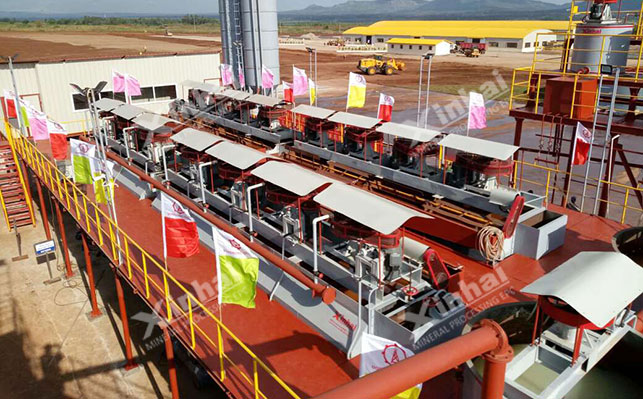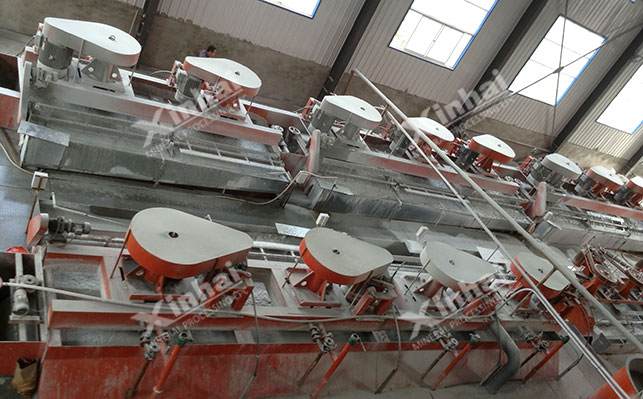
15311826613
Click to add WeChatCopper is an important non-ferrous metal, and its production and sales volume are second only to aluminum. Copper metal is mainly extracted from sulfide ores, and mineral resources are relatively abundant. Oxide copper ores account for a large proportion of them, and can be roughly divided into two categories: one is oxide copper ores with simple composition and easy processing, which are often processed by flotation; the other is difficult to process oxide copper ores, which are mostly processed by chemical methods. Although the mineral processing index obtained by chemical treatment methods is better, chemical methods such as acid leaching have a long processing cycle and slow recovery rate improvement, so flotation is often used as the preferred method for processing oxide copper ores. The following will elaborate on the commonly used copper oxide flotation methods: direct flotation method and sulfide flotation method.

Direct flotation is an earlier flotation method, which is mainly used to treat oxide copper ores with simple mineral composition and uncomplicated mineral properties. This method can be divided into three categories: carboxylic acid flotation, amine collector flotation and chelating agent flotation.
Carboxylic acid flotation: suitable for processing low-grade copper oxide ores. This method uses carboxylic acid reagents to react with the surface of copper oxide minerals. During the flotation process, the carboxyl group of the carboxylic acid reagent reacts chemically with the metal ions (such as Cu²⁺) on the surface of the copper oxide mineral to form a chemical adsorption, so that the mineral surface is covered with a layer of hydrophobic hydrocarbon groups, thereby changing the surface wettability of the copper oxide mineral, making it hydrophobic, and achieving separation from the gangue mineral. The reagent consumption of this method is relatively low because the carboxylic acid reagent has a strong selective adsorption capacity for copper oxide minerals, and only a small amount of reagent is needed to achieve a good flotation effect. At the same time, it has good selectivity and can accurately make the surface of copper oxide minerals hydrophobic and float, and effectively separate from the gangue minerals. In the case of significant differences in the properties of copper oxide minerals and gangue minerals, the grade of flotation concentrate can be increased to 20% - 30%, and the recovery rate can reach 70% - 80%.

Amine collector flotation method: refers to the use of amine collectors (such as dodecylamine, octadecylamine, etc.) for flotation. During the flotation process, amine collectors will hydrolyze in aqueous solution to generate positively charged amine ions. Due to the presence of unsaturated bonds on the surface of copper oxide minerals, hydroxide ions will be adsorbed in aqueous solution and become negatively charged. The positively charged amine ions interact with the negatively charged surface of copper oxide minerals through electrostatic attraction to achieve physical adsorption, thereby making the surface of copper oxide minerals hydrophobic. This method has a strong collection ability for copper oxide ores, but it is easily affected by ore slime, resulting in poor selectivity, so it is necessary to pay attention to the treatment of ore slime. This method can achieve better results when the crystal structure of copper oxide minerals is relatively complete and there are more surface active sites.
Chelating agent flotation method: It is mainly suitable for treating special copper oxide minerals with complex crystal structures, few surface active sites and covered by groups such as hydroxyl groups, such as malachite. Chelating agents composed of special collectors such as potassium octylhydroxamate, benzotriazole and neutral oil emulsifier are required for flotation. During the flotation process, the chelating agent molecules form stable chelates with the copper ions on the surface of chrysocolla through the coordinating atoms therein, making the mineral surface hydrophobic, thereby achieving flotation.
Although the direct flotation method has been used for a long time, in industrial practice, the fatty acid flotation method (i.e., the main reagent type in the carboxylic acid flotation method) has become the most widely used direct flotation method in the industry due to its advantages of low reagent cost, relatively simple operation, and strong adaptability to specific types of oxidized copper ores. It plays an important role in many small and medium-sized oxidized copper ore beneficiation plants.

The sulfidation-flotation method was mainly used for the flotation of lead carbonate ore in the early days, and has now become one of the common methods for the flotation of oxidized copper ore. In this method, the sulfidation process mainly uses sodium sulfide, which hydrolyzes in aqueous solution to produce HS⁻ and S²⁻ ions. Under the action of sodium sulfide, the surface of copper oxide minerals reacts, and a copper sulfide film with good floatability is formed on its surface, which transforms the originally difficult-to-float copper oxide minerals into properties similar to copper sulfide minerals, and can be effectively captured by conventional copper sulfide mineral collectors.
On the one hand, sodium sulfide, as an effective activator of copper oxide minerals, can promote the sulfidation of the surface of copper oxide minerals and enhance their floatability; on the other hand, when sodium sulfide is excessive, it will become an inhibitor of copper sulfide minerals or sulfided copper oxide minerals. In order to reduce the inhibitory effect caused by excessive sodium sulfide, a segmented dosing method is often used, and the dosage is adjusted in real time according to the sulfidation degree and flotation effect of copper oxide minerals in the slurry. Under suitable conditions, the sulfidation-flotation method can make the recovery rate of copper oxide ore reach 80%-90%, and the concentrate grade is increased to 25%-35%.
In summary, the richness and diversity of ores, different ore types and composition characteristics determine the need for appropriate flotation processes. Direct flotation and sulfide flotation both play an important role in the beneficiation of oxidized copper ore. Reasonable selection of flotation methods and optimization of process flow can not only improve the comprehensive recovery rate of ore, but also effectively reduce production costs.